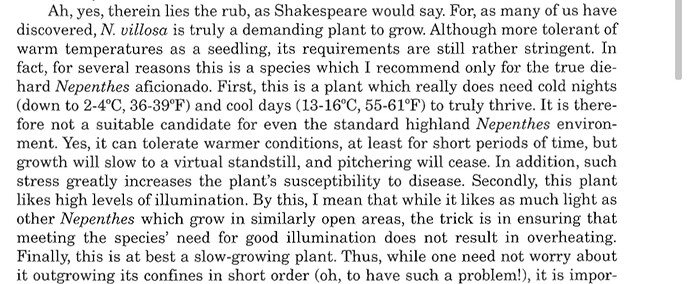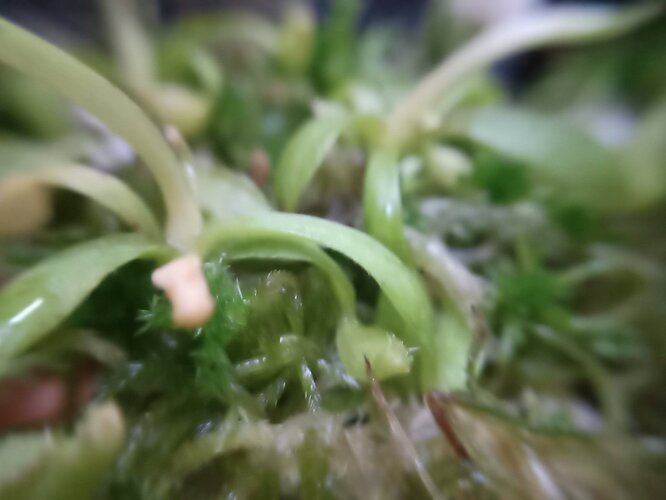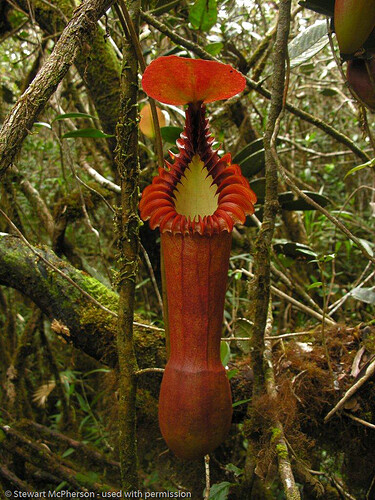I am not sure how I will use this space, but for now, I’m describing the project and may follow up with photo updates if something interesting happens.
Background:
Carnivorous plants are fascinating and a thriving hobby worldwide. They grow in various climates and are often exacting of growing conditions and will rapidly die outside them. Thus, for beginners, it is advisable to start with plants that naturally grow in one’s climate and then with experience, progress to plants that grow in more different conditions.
The location of this experiment is near Bombay. Hard lowland conditions, extremely rare for temperatures to drop below 20C beyond a week or so in peak winter. Plants classified as “ultra-highlanders” need day time temperatures that are cooler than our nights! and nights in single digits or under 15C in any case. Current night time temperatures in Nalasopara where I live are around 27C.
I am using my skill, insights and experience to grow highlanders in these conditions.
WHY?
Because some of those are really beautiful and rare species that would tempt any carnivorous plants grower and let’s just say I have low impulse control. lol
Key insights guiding my actions
Over the years, I have learned that most plants have some limited capacity to adapt over time. However, for it to work, the plants must survive till that time. Toward this end, I may take limited actions to meet temperature requirements, like putting a plant in a fridge overnight for a few weeks till it adapts to day conditions and starts growing, so that it doesn’t have to face all the adversity at one go - staggering the problems and giving the plant time to adapt.
Nailing ALL other growing requirements of a plant excellently often allows the plant to thrive even if one of them is not optimal. Which, in my case is temperature. So I am meticulous with ensuring they have light, good water, good root space, air circulation, etc Ensuring that there are no pests stressing the plant. And so on.
Good humidity when conditions are adverse often lets a plant survive in conditions that would otherwise kill it. The one non-frugal spending in this project is a misting system. Before I installed the misting system, I was routinely losing half my plants in the summer. After installing it, I can actually consider growing highlanders! That is how big a difference humidity makes.
Micro-climate. The climate immediately around the plants is as humid and cool as I can make it. Temperature wise, the difference may not be much, paritcularly in humid weather where evaporative cooling has little result. But by keeping plants close together, there is a small microenvironment created. This lets plants thrive much better than keeping them in isolated pots away from other plants. I don’t know why it works, but it does. Possibly by shading the roots and preventing them from overheating and killing the plants.
Nepenthes highlanders growing as a part of this project grow among the lowlanders, in the same microclimate. However, there are a few things I do differently for them.
- They do not grow in trays of water or on the floor. They are also not planted in solid plant pots. They are planted in net pots that are hung so that they get a lot of air circulation around the pot resulting in evaporative cooling of the roots.
- Their potting mix is less absorbent and requires more frequent watering than the one i use for lowlanders - which could be watered as infrequently as once a week. Frequent watering and the water evaporating create a cooling effect and flush out the soil and any nutrients in it (nutrient rich soil stresses CP roots).
- More frequent watering also pulls fresh air into the porus media as the water drains, resulting in better oxygenation of the roots, which in turn allows the roots to perform at their best.
- Watering with cool water at night in very hot weather. If the night temperatures rise above 30C for established plants and 28C when I have plants that are still acclimatizing, I will water the plants with water that is between 20C to 24C (NOT cold water - that will give temperature shock and kill the plant)
- Watering with cool water is a trick to pull out for any plant that may be doing poorly as an emergency measure outside routine practice.
- I have some observation of very controlled fertilization (without nuking the roots with nutirent overload) boosts plant metabolism and allows them to survive warm climates better. I don’t have the foggiest on why it works, but it works.
- By next summer, they will be growing in a balcony that gets the direct sea breeze for excellent ventilation + leveraging evaporative cooling better than the current set up.
What are the plants being grown in this experiment?
Most of the plants in the experiment are nepenthes, though I am also trying to grow drosera regia and drosophyllum.
- I have attempted to create a diversity of species based on altitudes intermediates (<1000m asl), highlanders (1500m - 2500m) and ultra highlanders (2500m+) - these are rough categorizations, as the adaptability of plants varies. For example, N. lowii would be an ultra-highlander, but does better in lowland conditions than some intermediates.
- I have attempted diversity in stages of growth that plants start growing here - seeds, seedlings, juveniles, tissue culture (buying adult highland nepenthes will take my kidneys being auctioned to buy one plant - which won’t be statistically meaningful, so, falling short of enough body organs to auction, I’ve skipped that for now, lol)
- I have attempted diversity in sources in terms of sellers. Sellers I’ve sourced material from range from Malaysia to the Czech republic in terms of climates the plants grew in before they came to me + different growers have different styles and some have more robust and established plants than others.
- Pure species and hybrids. I’ve collected several pure species as well as hybrids between highlanders, highlanders and intermediates and highlanders and lowlanders. Hybrid vigor is one aspect I’m interested in leveraging - hybrids often grow faster than their parents (though not always) and are more tolerant of a wider variety of conditions (also not always). One strategy in the back of my mind is to get the plants growing very robustly through monsoon and winter so that sheer momentum of growth carries them through the summer - depleted, perhaps, but alive.
There is a hell of a lot more thinking, planning and preparation gone into this, and I’ll add things I can think of as worth documenting.
Disclaimer: There are no references for this, not even among informal grower forums. All the references agree that the plants in my balcony should be dead. The only grower I know to try something like this is one who used to grow them in Hawaii about two decades ago to a decade ago. I have no idea what happened of him since and am not able to find him, but his forum posts are a source of good information on growing highlanders in the lowlands, and I do read everything I find from him.
If this works, it will basically refute a lot of established knowledge on growing conditions. Including published research. If it doesn’t work, I’ll have spent lakhs of rupees for no result. But it is an experiment worth doing.
Disclaimer 2: I can’t move this experiment to the CUBE, because it takes daily monitoring and a very skillful eye to spot problems early and do constant tweaks to keep things optimal. I can’t delegate this and I can’t come to the CUBE daily. The experiment remains in my balcony. Perhaps we can move some of it or create a parallel one eventually if enough people in the lab learn to grow CPs.


